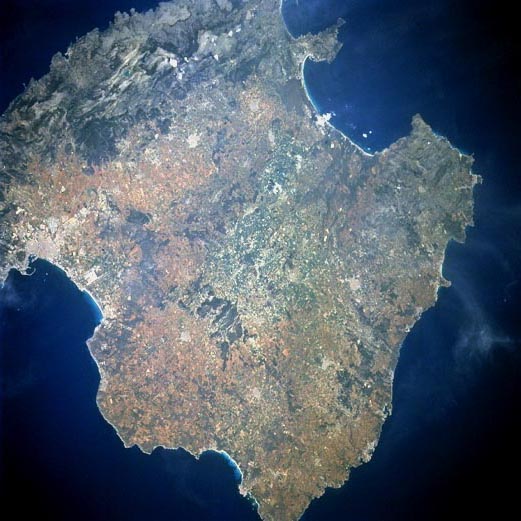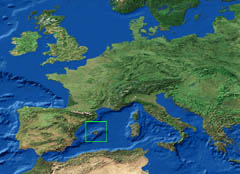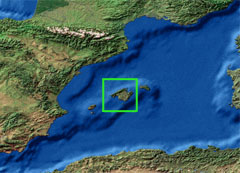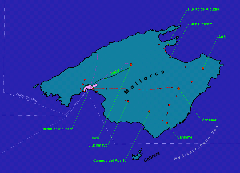 |
 |
 |
|
 |
2007 CupInfo: Potential Locations for the Defense
Lisbon/Cascais, Portugal | Marseille, France | Naples, Italy
Palma de
Mallorca, Spain
|
Valencia,
Spain
|
Palma de Mallorca,
Spain Palma de Mallorca is the capital city of the Balearic Islands. Located on the island of Mallorca in the western Mediterranean, off the eastern coast of Spain not far from Valencia, Palma offers a dramatic setting for America's Cup racing. On
September 5th, SNG/ACM removed Palma from the short-list of host
candidates. |
| General Information: | ||
| Population: | 349,690 | |
| Official Language: | Castilian Spanish (official) 74%, Catalan 17%, Galician 7%, Basque 2% | |
| Business Competitive Index: | Spain Rank: 25th (about the BCI) | |
| Productivity: | GDP per capita, Spain Rank: 22nd | |
|
Travel Information: |
||
| Main Airport: | Serviced by Iberia, Air Europa, Spanair and Vueling | |
| Rail Service: | None | |
| Ferry Service: | Ferry service to mainland Barcelona (3 hrs) and Valencia (8 hrs), and neighboring islands of Menorca and Ibiza | |
| Time Zone: | GMT + 1 | |
| Electricity: | 220 volts, 50 Hz AC |
Met data:
|
Brief History: |
||
| Palma de Mallorca is the capital city of Mallorca
or Majorca, one of the Balearic islands. The Balearics, off
the eastern coast of Spain are divided in two groups: Gimnesias
(Mallorca, Menorca and Cabrera) to the North, and Pitiusas (Ibiza
and Formentera) to the South-West. The city has several unique sections: Casco Antiguo, (the old quarter), Avenidas, Sa Llonja, Paseo Marítimo, (the sea front), Es Jonquet, Gomila, El Molinar, S'Arenal and Génova. The Old Quarter is the tourist section with historic churches & museumsLas Avenidas (The Avenues) refers to the five avenues that that run to / through the city from the Paseo Maritimo where most of the good shopping can be found. Sa Llonja is the area where nightlife abounds with many restaurants and bars. The Paseo Maritimo is at the sea with cafes, restaurants and numerous nightclubs. El Moliner is an old fishing section on the seafront, one likely candidate for a Cup village. Those who colonized the Balearics include the Iberians, Phoenicians, Greeks, and Carthaginians. The islands were under Arab sway for over five centuries leaving a rich legacy of habitat, embroidery, technology and ceramic painting. Arab domination ended when Jaime I, the Conqueror, founded the Christian kingdom of Mallorca. Alfonso III of Aragón, fought against Jaime II of Mallorca until the kingdom of Mallorca was united with the kingdom of Aragón. The story of the Balearics became increasingly intertwined with that of Spain. Mallorca offers fine dining especially in the abundant local fish and seafood dishes. The caldereta de langosta (lobster stew), cap roig (sea scorpion), fish croquettes made with jonquillo (white meat of gobie), all are a superb way to relax & enjoy sunny Mallorca. Palma is also a center of Spanish social activity in the warmer months when Palacio Marivent serves as the summer residence of King Juan Carlos of Spain. |
Official Palma
America's Cup Venue Website
More information:
CIA Factbook - Spain
Lonely Planet Guide - Balearic Islands
|
STS090-714-074 Mallorca, Balearic Islands, Spain April 1998 |
||
|
Mallorca, the largest of the Balearic Archipelago (1405 square miles-3640 sq. km), which is located in the Mediterranean Sea east of Spain, is a natural bridge between the smaller islands of Menorca (northeast) and Ibiza (southwest). This chain of islands, popular tourist destinations, represent a continuation of the Sierra Nevada mountains of southern Spain which are part of the much larger Alpine system found throughout southern Europe. The Sierra De Tramontana, the most easily recognized mountain range on Mallorca, parallels the entire northwest coast of the island (center of image) and along the east, southwest coast. The rural landscape includes olive and almond trees, as well as strands of pine, fruit, and evergreen oak trees. Approximately half of the islands 650000 people live in he capital city of Palma. Palma is visible in this picture along the northern edge of the Bay of Palma (bottom-center). The two parallel runways (light colored, linear feature) of the busy Palma airport are visible immediately south of the city.
Earth Sciences and Image Analysis, NASA-Johnson Space Center. 2
Sep. 2003. |
||
|
*Business Competitive Index is a measure of strength and opportunity in the business environment. The BCI is compiled by the World Economic Forum as part of their Global Competitiveness Survey. A simple explanation would mention that it is related to a country's GDP per capita, but, as might be expected where economists are at work, the analysis is much more complicated than simply that one ratio. See their website for more information. |
Inquiries please contact: